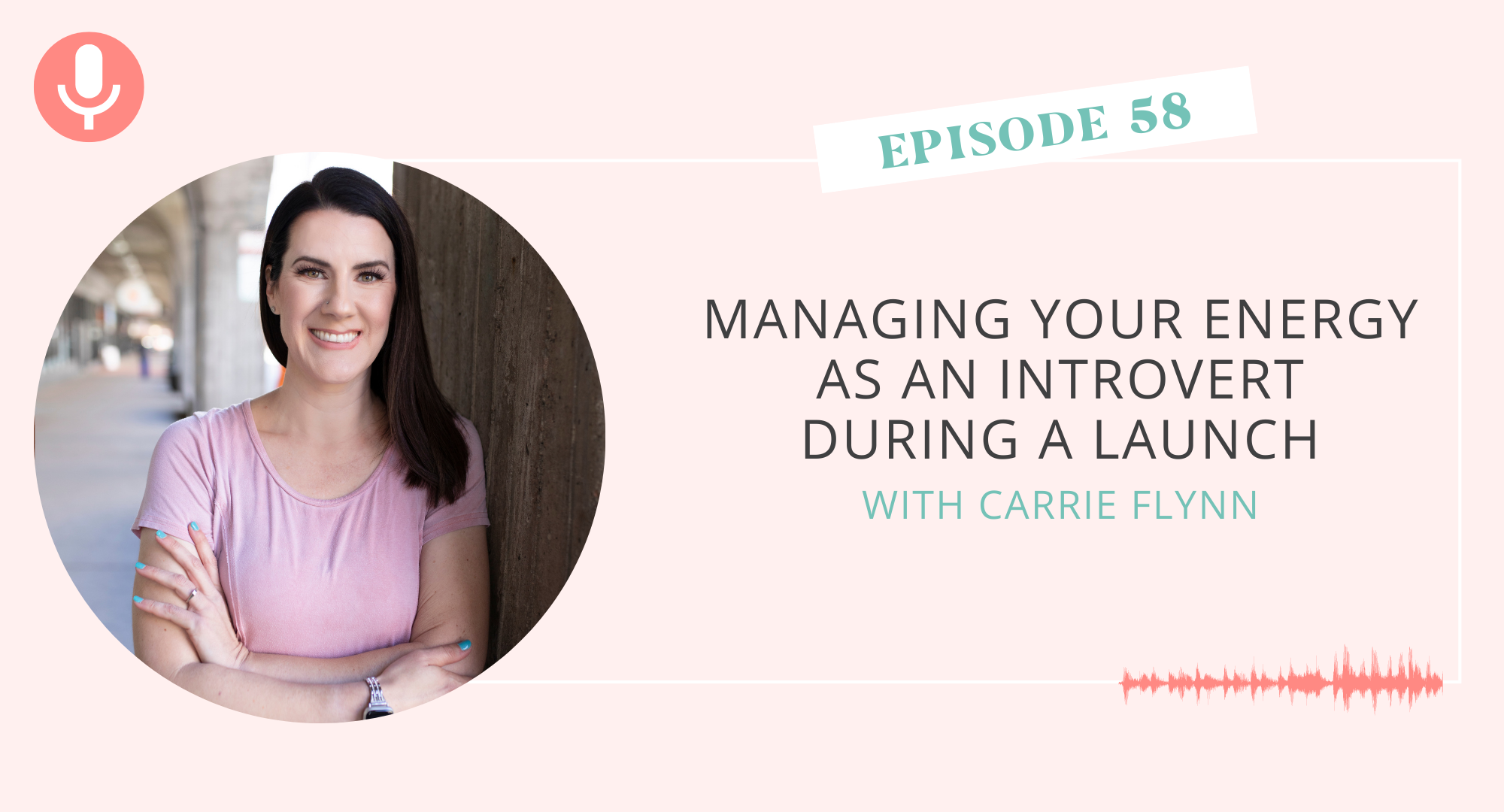Struggling to get the results you want from your emails?
Discover 15 simple yet powerful ways to elevate your email marketing and start seeing real engagement!
Grab your freebie!
Blog Categories
Helping small business owners, virtual assistants, and creative entrepreneurs grow their business.
Hi, I'm Tara! I'm a multi-passionate business and marketing coach.
learn more + get a copy:

Disclaimer: I earn from qualifying purchases. Some of the links on my website are affiliate links, which means, at no additional cost to you, I will earn a small commission if you click through and make a purchase.
Do you dread launching when you decide to bring on digital offers to your business after only offering one-to-one services? It can be an overwhelming process for newbies and seasoned entrepreneurs. For introverts, in particular, you have to be very mindful of your energy when it comes to launching because it requires extra energy and managing those expectations. Along with managing your energy, you want a launch strategy that best fits how you market your business. Let’s take a closer look at some launch tips that will help you grow your business sustainably as an introvert.
Our guest on the podcast today is Carrie Flynn. She is the owner of Virtual Simplicity, LLC, which specializes in helping her clients get their online programs created, designed, and ready to launch using her Zen Launch Formula, so they can launch easily and maximize profits quickly. Carrie and her team offer Launch Accelerator Days and 1:1 Launch Consulting.
Carrie loves yoga, her daily coffee, British TV shows and movies, and college football (Go Gators!). She’s been married to her husband for 17 years, and they have two daughters, ages 13 and 5. Carrie lives near the Orlando, FL, area with her family.
In this episode, Carrie and I dive into:
- How she became a launch strategist + marketing consultant from working as a public school teacher
- Energy management for introverts during a digital product or program launch
- Incorporating digital products in your business as a second revenue stream
- The different launch levels and what tech tools best fit where you’re at
- …and much more
Full-Time Public School Teacher Turned Launch Strategist + Marketing Consultant
Carrie started her career as a full-time public school teacher. In 2017, her daughters were six months and eight years old, and she started looking for something that would allow her to do two things; bring extra income into her family’s budget and enable her to use her creative side. At least that was the original plan. However, she began to plateau in her teaching position and had no creative opportunities. That’s when she started her virtual assistant business, which scaled into an OBM or Online Business Manager business. For the first couple of years in that business, she worked with her clients to help them regularly launch in the coaching and consulting industries. This gave Carrie on-the-job training on launching, what that meant, and all the different things that went into launching.
When covid hit in 2020, she moved into launching as its own service. She was no longer just someone who works on a team for someone else as an OBM. Around the end of 2021, she noticed how many people hated launching and only saw it as a necessary evil to grow their businesses. As a huge fan of simplicity, Carrie had already felt like many things were happening in that space that was unnecessary anyway, so she and her team developed a way for their clients to launch without burning their business into the ground afterward.
This Zen Launch Formula was created through Carrie’s many client experiences and watching friends and colleagues struggle with the whole launch process, not wanting to do it but feeling like it was imperative. Witnessing these experiences was hard for Carrie because she felt that people started their own businesses to enjoy what they were doing instead of dreading it. However, knowing she could help others have a better experience, she utilized her Launch Manager Certification and Certified Master Marketer Program and her experiences to put together a process of launching without fear.
Managing Your Energy When Launching a Program or Digital Product as an Introvert
As an introvert, Carrie has found that energy management was a huge issue for her when launching. She is not shy or afraid to show up online, but the struggle for her is the energy drain of socializing. You must consider and manage your expectations for being present on social media. It’s essential that with whatever you choose to do for the ongoing strategy that you plan in ways to manage your energy. It can be a very tiring process, especially for introverted entrepreneurs, to expel energy online, so self-care is needed. It may sound silly, but you must be more strategic in mapping out or planning things.
If you know that having meetings and calls online drains your energy, then decide how many you can handle in a day or a week. Then, you can have those days planned out, so the other days can be focused on your business and your clients. Another way to take advantage of this time is when you put effort into putting yourself together for an interview or meeting. You can also create content, take brand photos, and record training materials, and it’s a great way to make use of your time.
How to Incorporate Digital Products as a Second Revenue Stream For Your Business
Carrie considers herself an excellent example for adding digital products to her revenue stream. Although her primary services are one-to-one, she utilizes digital products to help people who come to her and aren’t necessarily ready for her done-for-you services.
What has helped her a ton is to consider if your one-to-one service is your highest point of entry for somebody on your value ladder in terms of your offers. Then your type of client will be at a certain income level and specific place in their business. So you want to think backward and work down by adding a digital product or program that could be the next level down, or you can go even further down the ladder to the point of entry.
When you’re thinking about a digital product, it could be a d-commerce store where you sell templates, but there are many options to choose from. One thing that is very helpful in learning what your audience needs is using relationship marketing. There’s nothing more powerful than when you’re just talking to people and paying attention to what their needs are. The needs of someone new to launching will be very different from, for example, the one-on-one consulting services that Carrie offers. She only figured this out after conversing with folks and paying attention to the spaces she was in and people’s pain points. Understanding this has helped her in creating the K30 Roadmap course.
Carrie’s most significant advice is that you don’t want to create the digital product first, and it’s the same as you would do with your services. You want to find out where your audience is, their biggest pain points, their needs, and what the transformation is you can provide for them.
Is it a course?
Is it a workshop?
Is it a PDF?
What would they need that would help them get a quick win? Many people are at that entry point level or the mid-tier level and are not quite ready to invest in totally done-for-you services. So what could you give them to help ease that pain a little bit that they could do on their own?

The Different Launch Levels and What Tech Platforms Best Fit Your Stage in Business
You don’t necessarily need many tech systems or platforms at the beginning. However, through her certifications, learning about launching, and just working with clients over the last five years, Carrie has learned that depending on your launch level, there will be a tech system that will best fit your needs.
The first two levels are for the person new to launching, and then the second two levels are more established as you’re becoming more of the thought leader. A thought leader or someone who’s scaling an offer would use something completely different than what someone would use at the beginning. You may not even need a system or a tool to have a sales page. You can 100% get away with having a Google document. Sometimes people get so caught and stuck in this conversation that they don’t ever launch. If you are new to launching, you can start with your sales page as a Google document. If you have a remarkable transformation that helps people get from point A to point B, start where you are with a Google doc, and then go from there.
There are some great tools out there, depending on where you are. If you’re starting out, LeadPages or Teachable are user-friendly, and they’re not a significant investment if you’re at level one or two of launching. As you become more established, you can start to scale into some higher, more advanced tools like Kajabi. Kartra is another excellent option, along with FG funnels. They all do different things. They’re also not perfect, as they all have gaps. It’s essential to look at them and see which style works for you and which is user-friendly for you. Don’t do it if it’s tough for you to use. You don’t want to stress yourself out over a tech tool.
Mapping Out a Launch Strategy in Three Phases
Carrie mentions you should go through three parts to the launch strategy.
Phase One
This phase is all about your strategy. This is also a time when you are making decisions. You will decide when to launch and what type of sales event you will do. You also look at putting together your visibility plan as your overall marketing plan for how you will get this digital product in front of people.
Phase Two
This is the design phase. This is where you create any new tech, update your course, build your sales page if you need to do that, and write that copy. This can be a two-month process when Carrie works with clients because she and her team like to test things and make adjustments if needed.
Phase Three
This is the actual launch phase. You have your sales event, open the doors to your program, and show up. After the launch is over, you debrief it. You take the time to break down all the numbers, look at did it go well, and what didn’t go well, and then you can take that information and make some adjustments. Carrie encourages people after the launch is over to give themselves a week or two to rest and do business as usual.
For introverts, especially, taking care of yourself during phase three of your launch strategy is vital. So many people only focus on the goals, the plans, and the strategy, but they miss this critical component. Launching a digital product can be draining and stressful, so yes, you want to push for growth and do that in a way that allows for radical self-care. This kind of care can look like planning ahead of time, going outside daily, saying affirmations, meditation if you’re okay with that, celebrations every day, and planning ahead during the launch strategy. Another thing Carrie encourages during a launch is massages because it helps with the lymphatic system and getting that out of your body.
Carrie has given some phenomenal tips and insights on managing your energy during a launch, the different levels of a launch, mapping them out, and which tech tools to use, especially as an introvert. Be sure to check out her website to learn more about how to work with her or connect with her on social media through Instagram and LinkedIn for more launching and energy management tips.
If you have done a launch before as an introvert, did you pick a launch strategy that drained your energy, or were you able to manage it effectively?
A Breakdown of This Episode
[1:39] Carrie’s background as a public school teacher and her journey to becoming a launch strategist and marketing consultant
[6:25] Energy management tips for introverts launching digital products for the first time
[11:59] Incorporating digital products as a second revenue stream in your business
[18:03] Different levels of launching and the tech platforms that will best fit your needs
[21:13] How to map out your launch strategy for success
[28:31] Carrie’s favorite marketing method and platform for her business
If you enjoyed this episode, I invite you to drop a five-star rating + review with your biggest takeaway, so that other introverts can find this podcast for guidance and support through their introvert entrepreneur journey!
Download the Episode Transcript
Resources Mentioned in the Show
- TheTaraReid.com
- Join the Introvertpreneur Club
- Grab My Free Resources
- Programs I Offer
- Sign Up For One of My Courses
- Coaching Services
- Shop My Digital Products
- The Offer + Value Ladder Workbook
- Carrie’s Instagram
- Carrie’s LinkedIn
- Carrie’s Website
- How to Work With Carrie
- Zen Launch Checklist
Tara Reid is a multi-passionate business and marketing strategist for introverted entrepreneurs who want to grow without relying on hustle culture or social media. With 18+ years of online business experience, she helps course creators, service providers, and digital product sellers build sustainable businesses through evergreen marketing, blogging, SEO, Pinterest, and email.
As the founder of the Introvertpreneur Club, Tara’s mission is to show heart-centered entrepreneurs that you don’t have to be loud to be successful. You just need the right strategies that fit your personality.
When she’s not supporting clients or creating new resources, you can find her at home in Canada with her three rescue dogs, a cup of coffee in hand, dreaming up her next project.
The Introvertpreneur Podcast
listen in to the top rated business podcast that is designed for introverted entrepreneurs who want to grow + scale in a more sustainable and fun way!
Top rated podcast
This one's on me. Complimentary free stuff coming right up.
leaving so soon?
Look behind the curtain and see exactly what I do every week, month, and quarter, to market my business without social media (in under 5 hours per week)!
The Quiet Marketing Playbook
Take this free quiz and learn what your superpower is as an entrepreneur. You'll also get a curated list of my best resources and tips for using your superpower to your advantage!
What's your Introverted Superpower?
Best Free Resources:
dig into 'em now!
A business strategist and marketing coach who focuses on helping course creators, coaches, and service providers, build sustainable businesses without social media.
